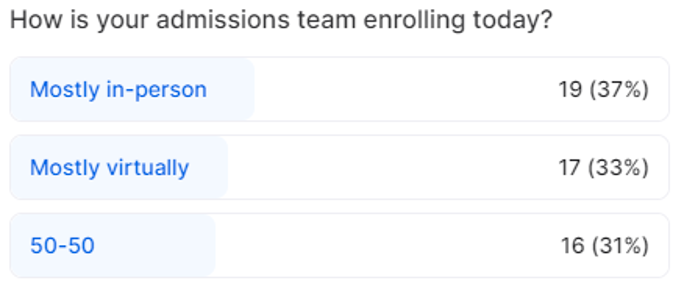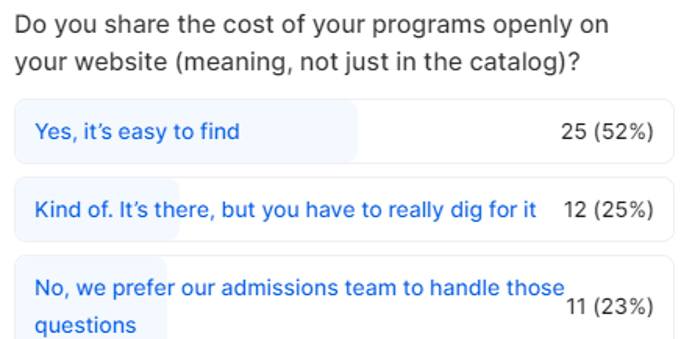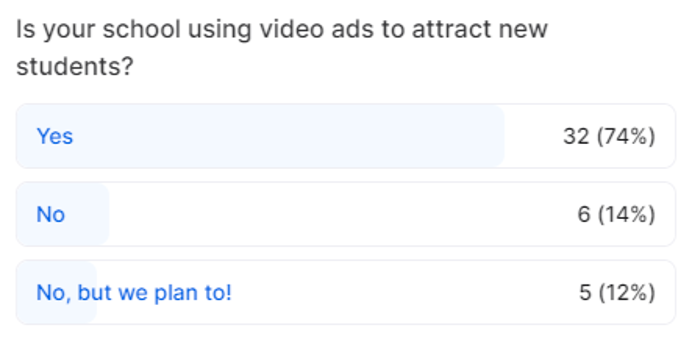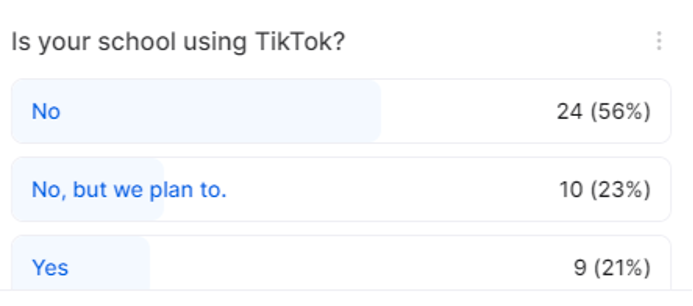We surveyed more than 150 admissions professionals and found their top enrollment challenges are:
- Increase enrollment
- Generate new leads
- Motivate the team
We then wanted to gather some of their insights, so we conducted a webinar facilitated by expert enrollment consultant Jenn Lyles, which featured a panel of admission experts:
- Joy McClure, Tricoci University
- Paul Matylonek, Tricoci University
- Michael Collins, Unitek Learning
- Samira Zacharias, The Modern College of Design
Jenn asked the panelists for their perspectives on an array of topics you’re bound to find interesting—largely related to changes imposed by the pandemic. She also injected her point of view on many of them. You can watch the webinar in its entirety here or keep reading for the highlights.
Here we go…
Campus tours
Jenn began by asking the panel:
Q: How did, or does, your admissions team perform tours?
Michael: We have brick and mortar campuses and our programs are allied health and nursing. It’s very hands-on. Prior to the pandemic, we were ground tours only. The interview was done in person, completely. Every student would come in and the tour was an integral part of their experience.
Michael was asked to explain how they adapted.
Michael: It’s an ongoing process. We were able to use a screen-sharing software platform that definitely helped, but development of images and video is something that we’re in the process of working on currently.
At this point, we can do scheduled tours, but we’re planning on keeping campuses continuing to do remote enrollment even without shelter-in-place restrictions.
Samira: Once the pandemic hit, we quickly changed to do a lot of virtual. We came up with a presentation where we screen-shared, so it’s a lot easier for us to be doing the virtual side now, and we continue to do it.
We don’t see the virtual going away at all, because it’s a lot more convenient for students.
Joy: We were 100% brick and mortar. A person came in and they toured the facility. We did have to pivot quickly—and we haven’t gone back. Even if the admissions advisor is on site, they’ll still continue to do interviews remotely, and we’ve developed a lot of tools to make that a really effective way to conduct an interview
We know some people will still want to come in, but we can really represent many campuses this way. It’s an efficiency play, a better way to use your staff as well.
Joy claimed going remote resulted in show rates going up 10% to 20%.
Paul: We created amazing videos and interactive features. Our virtual tours became very interactive, even in a remote setting, so it really helps to engage the student.

Results from a poll conducted during the webinar show a fairly even split between in-person and virtual admissions processes.
Publishing tuition fees
Q: Do you publish the costs of your programs on your website?
Michael: You can find it if you can find a catalog, but other than that, we’re not upfront with it because we’d rather learn about them first and make sure they’re going into the right program.
Samira: Yes. it’s easy to find. If parents, or anybody, have any questions, obviously we’ll direct them to where it is if they want to see it, but we are full disclosure.
Joy: Ours is pretty easy to find. It’s in an FAQ. We did an A/B test to see how it impacted the bounce rate on our website.
We know SEO (or organic lead traffic) is one of our best performing channels. When we were making the information easier to find, people would stay longer on the site. They were more engaged and more likely to fill out a form requesting more information. If it was hard to find, we found they would bounce, so it improved our bounce rate.
Paul: There was definitely a time when no one really published published their tuition. Then I believe it shifted in the 2010s when the Gen Zs were coming into play. Let’s face it, we want to trust the organizations that we’re dealing with. If we’re buying anything at all, we want to see the price.
Jenn offered her point of view…
I think a lot of times, when you can’t find a price, whether it’s a car or a house or sunglasses, you’re telling me it’s too expensive.
Another thing is people could just Google it, like, “How much does this school cost?” And what if other people are answering it incorrectly on like Yahoo Answers? I think it’s better to put everything out there and then create more value propositions to help them understand that value.

An audience poll at this point in the webinar revealed the majority of colleges now publish tuition fees.
Marketing with video
Q: How are you incorporating video into your marketing strategy?
Samira: We use a lot of videos on our website and we can text videos to you. When a student is accepted in the school, our president records a video with that student’s name and sends it to them to welcome them to the school.
Michael: We are very heavy with Instagram, all social media platforms. We have someone whose main job is to do that with our alumni base, current student base, and then just working with marketing for lead gen as well. So videos are definitely a key component through all of our different channels.

Most schools use video ads in their marketing.
Jenn told the audience 70% of the US marketers plan to use social video ads in the next year, and four times as many consumers would rather watch a video about a product than read about it. Then she wanted to know…
Q: Does your school have an active YouTube channel?
Michael: We’re definitely using YouTube.
Paul: Tricoci has its own channel for sure and we have used it in the past five, six years.
Q: Does your school use TikTok?
Joy: We use TikTok, and I think it really speaks to our student group.
Samira: We do, but not as much as I think we would like to.
Michael: That’s in the works. We’re local-based, so we have to be cognizant of that, but that’s definitely now part of our mix.

Only 21% are using TikTok to market their college.
Budgeting
Q: Is your marketing budget focused mostly on digital?
Joy: We’re almost 100% digital. We really don’t do traditional. We do have high school outreach, but we won’t spend money on brand awareness at this point; it’s all digital.
Samira: We are digital for now, but we are looking to go back to the high school market. That was our forte back then.
Michael: I would say we’re about 90, 95% digital. When we do traditional things like billboards, it’s really focused on a new program, or a new location, new branch.
Responding to the pandemic
Q: How did enrollments go during the pandemic?
Joy: We actually saw a year-over-year growth, record numbers for us.
Michael: Record number of increase for nursing. For our lower-level programs, our certificate level allied health programs, there was a decline.
Samira: Twenty percent less during the pandemic, and now we are back on 20% more what we had the previous year.
Q: Are leads up or down year over year?
Paul: We’re definitely up year over year, and enrollments are up too.
Michael: Up.
Samira: Leads are slightly up and I think enrollments are a lot better.
This question came from a viewer:
Q: Are you seeing more drops or worse retention, especially in the first few weeks of a start?
Joy: When things were still really locked down and we were offering the education in a hybrid model, there was really no reason for people to miss school. So, we actually saw some of our highest attendance rates, but we have started to see that go down recently.
Michael: As things have opened back up, we’re seeing more drops than we were during the pandemic.
Chat assistance
Q: Do you have live chat on your website?
Paul: We do have a chat feature there, a third-party chat feature, but not a chat feature that actually directs to a significant person in the admissions department.
Samira: No, no chat on the website. We do have a chat robot that chats on one of the landing pages.
Michael: We have used chat in the past, but since we’ve gone to doing career planning and interviewing remotely, we’ve moved away from it.
Joy: We tested this. If you’re on a PC, we found that it still is engaging and so it’s on the site. It does not show up if you’re on a mobile device. We’ve struggled with should we just eliminate it altogether, but we saw that we still had a higher engagement and lower bounce rate.









